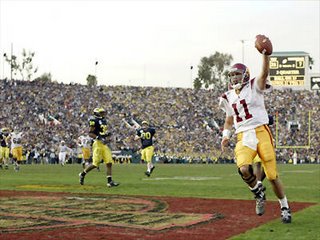The Erosion of Michigan Football With Numbers

The erosion of Michigan football under Lloyd Carr is a topic I wrote about back in May and one that everyone who watches college football has noticed, but since I found an archive of college football box scores going back to 1995, I decided to revisit the erosion and see just where Michigan football had fallen off. A quick, dirty way I separated Lloyd Carr's coaching career was to compare the 1995-2000 Wolverines to the 2001-2005 versions in terms of offense and defense and further breaking it down into non-conference and conference games.
The 2001-2005 Wolverines scored more points than their predecessors, averaging 29.9 points a game to the 1995-2000's 27.8 points. They scored more points despite having lower yards per passing attempt, yards per catch, completion percentage, and a lower yards per rush. One reason for the slight increase in points is that the 2000-2005 version threw the ball an average of 5.6 more times a game, completing 3 more passes, and rushed the ball 3.4 less times and passing yards are more likely to result in extra points on the scoreboard.
Defense is the main difference between the split halves of Carr's coaching career. The defenses for the 1995-2000 teams allowed 16.6 points per game, lower than the 20.2 points per game allowed by the 2001-2005 teams and making up for the 1995-2000 offenses average 2.1 less points. Also, the former defenses allowed less rushing yards on more carries and a lower completion percentage to the opponents (.536 to .553).
Just looking at the non-conference opponents tells a similar story across the two time frames. Again, the 2001-2005 offenses averaged more points than from 1995-2000, but this time the margin shrunk from +2.1 points to only +.8 points. Again, those teams scored more points on average despite having lower yards per pass attempt by a whole yard), lower yards per catch by 1.3 yards, slightly lower yards per rush, and a lower completion percentage.
As for the defenses against non-conference opponents, the 1995-2000 teams once again bettered their 2001-2005 allowed 3.4 less points per game. The most marked difference between the defenses in non-conference games was a much lower completion percentage for the 1995-2000 teams (.532 to .571). Whether this is a result of poorer defensive line play of the more recent Michigan teams or worse defensive back play or both or better Big 11 quarterbacks is debatable, but there is no confusing Michigan's pass defense is worse now than it was in the past.
If you have been paying attention so far, it should not surprise you that the numbers are basically the same for Michigan in conference games. The offenses of 2001-2005 score more points (+2.7 points per game) while having worse peripheral numbers, although the completion percentages are identical to the 1995-2000 teams, and the defenses of 1995-2000 give up 3.8 fewer points per game, once again eliminating the advantage for Michigan's 2001-2005 offensive efforts.
Lastly, I compared the Pythagorean winning percentages of the two time frames to each other, again by overall, non-conference, and conference results. The Pythagorean winning formula for football is the same as it is for baseball, but the exponent is 2.37 instead of 1.83.
According to the formula, overall over a 12-game season, the Michigan teams' point differentials of 1995-2000 add up to .7 more wins than the ones for 2001-2005. This difference may not sound like much, but this is an erosion and .7 wins is a big deal in a sport where losing one game almost automatically puts a team out of national championship contention. In non-conference games, the 1995-2000 teams were .8 wins better and in conference games, they were .6 wins better.
If the seasons were increased to 13 games, which is how many games several teams are playing now, the 1995-2000 teams were .8 wins better overall, .9 wins better in non-conference games, and .7 wins better in conference games.
In summation, the most erosion seems to be occurring on the defensive side of the ball as it is totally negating the increase of points the offense is scoring now.

